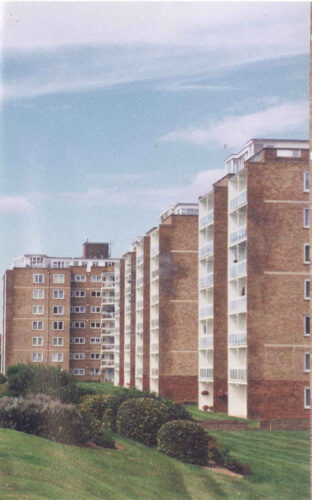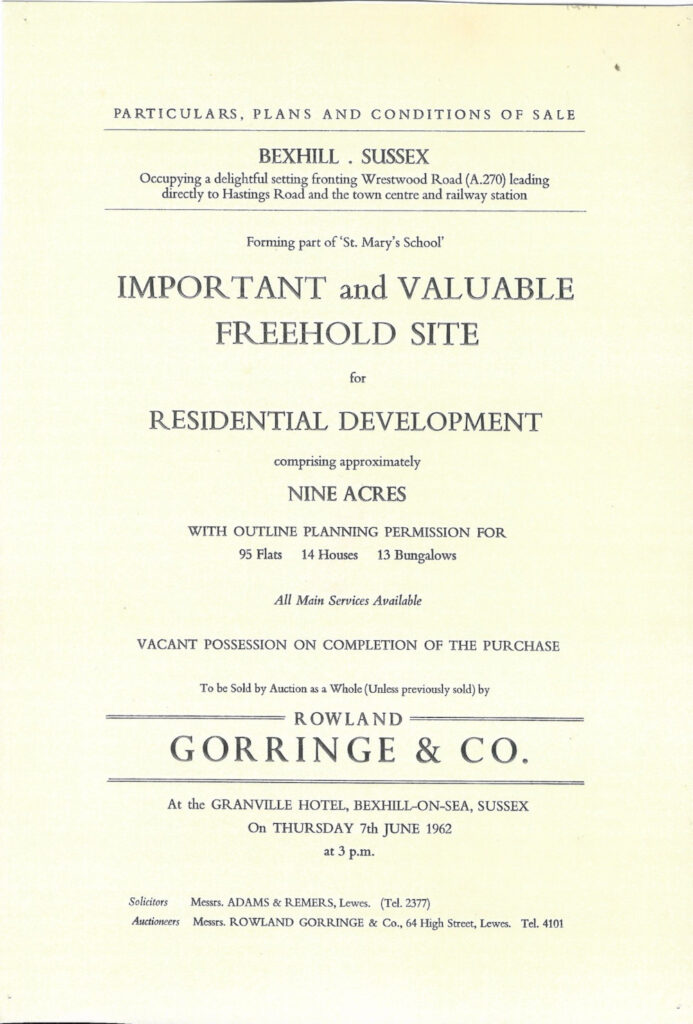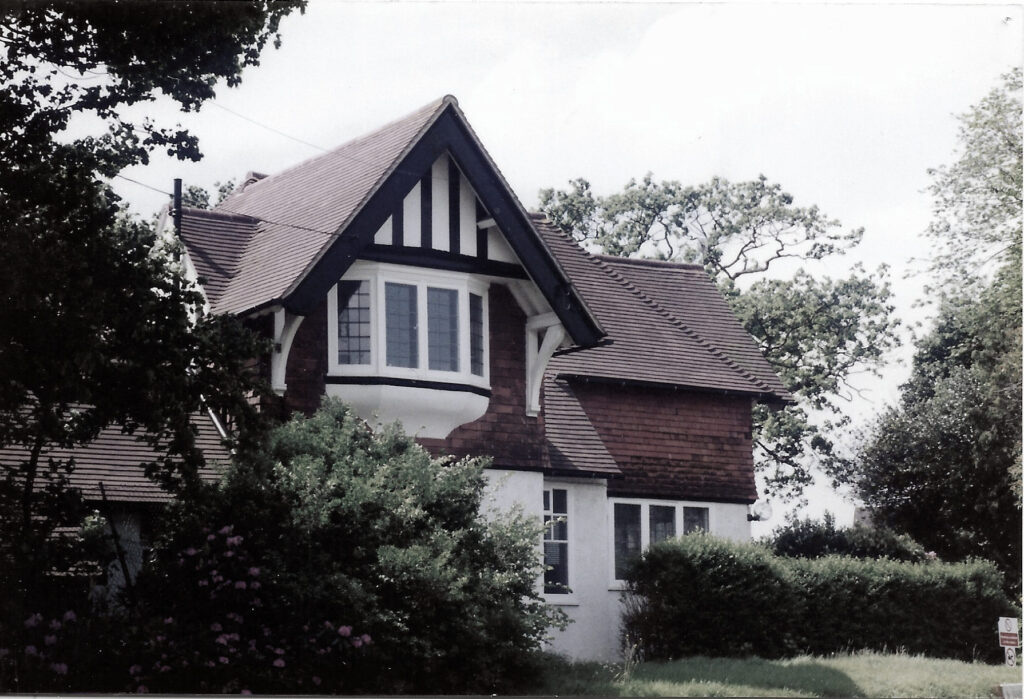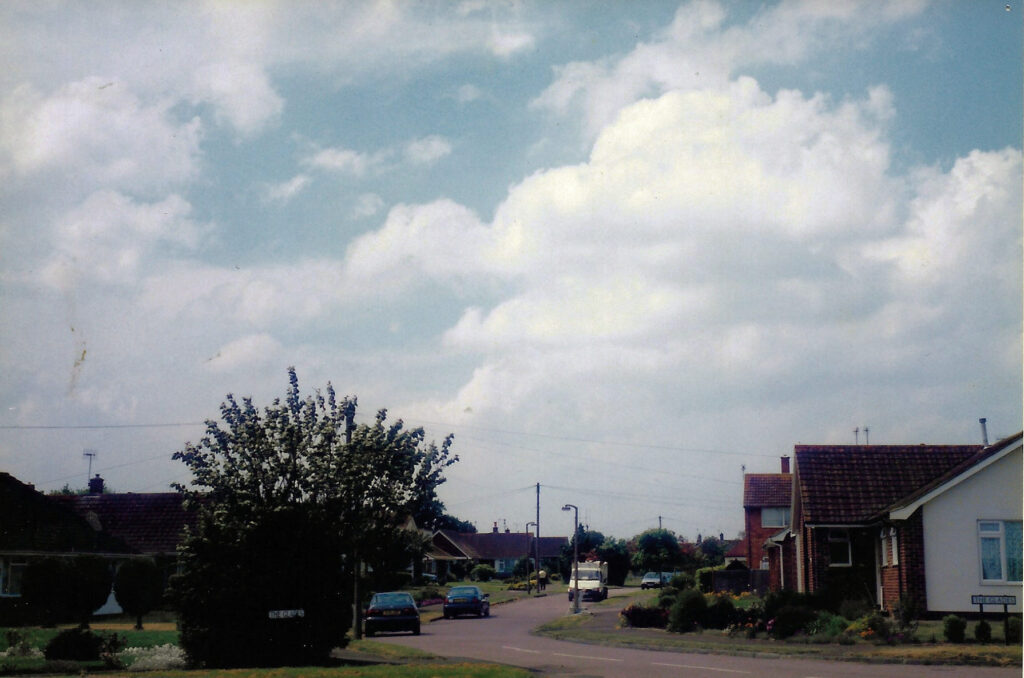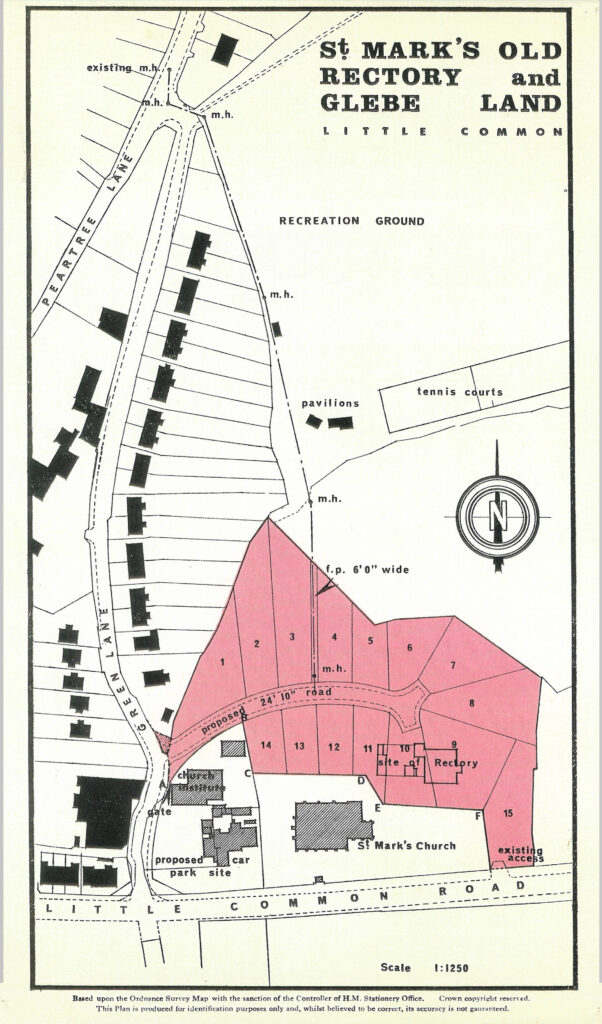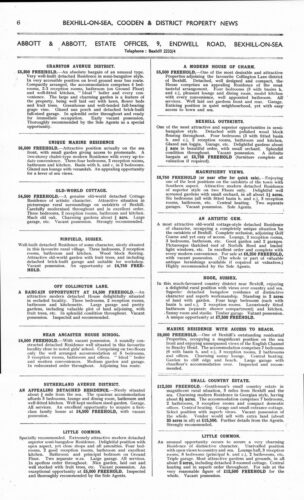The Larking Family
When R. (Reg) A. Larkin first came to Bexhill in the early post-first world war period he started sub-contracting in Knebworth Road. Conditions on the site were shocking and there was no organisation.
He knew that during bad weather men were unemployed for many months at a time. After founding the firm of R. A. Larkin & Brothers in 1924 he kept a small staff going all the year round by retaining some land for building ‘spec.’ houses while waiting for another contract.
An early development was Walton Park. A large part of Broadoak Lane, Broad View and Wardway were built on the site of Careys old brick yard.
The firm went on to develop part of the north side of Cooden Drive, the White House Farm estate, Newlands Avenue.
The post-war period saw the need for flats and Millfield was converted and blocks built on the site of Normandale School and Thornbank and the `West Indies’ blocks built over a number of years.
Individual houses were built in Maple Walk and Clavering Walk. Probably the finest was ‘Cordova’ in South Cliff, built for Sir Eustace Watkins.
Estate Agents still, today, advertise ‘a Larkin-built property’ as a guarantee of a ready sale.
The Larkin Family Firm
2,000 Larkin-built homes in Bexhill since 1924 a major influence on town growth from modest beginnings.

Left to right: R. A. Larkin, Jack Larkin, Geoff Larkin &Norman Ward.
To the question ‘What local firm has built nearly 20 per cent of modern Bexhill?’ Most people would rightly answer `R.A. Larkin and Bros.’ though few might realise the real extent of that contribution to the town’s growth.
Since 1924, when an ambitious young man in his mid-20s came to Bexhill with little more than his wartime savings, nearly 2,000 Larkin-built houses have gone up in the town. At Woodsgate Place (surely one of the most attractive settings a builder ever had for an office) – the house itself is also Mr Larkin’s home. `R.A.’ as he is known to so many, talked to an ‘Observer’ reporter about the career which has been, and still is, his life. At 72 he continues to be the driving force behind the firm, though for the past 20 years he has been at the head of a closely-knit team which includes both his brothers.
`I was born at Tonbridge and joined the Royal Naval Air Service in 1916, coming out of the Service in 1919,’ he explained. ‘I had been apprenticed to the building trade as a plumber at Tonbridge, and I went to the Technical Institute and studied as a draughtsman at night. I took the first part of my examination, and then the war came along and I was accepted into the Air Service as a draughtsman. This training has always proved useful because I do all my own plans and the architects tidy them up for submission to the Town Council. After the war I went to work in Lancashire for four years, and in Wales, and in 1924 decided to start my own business.’
Asked why he chose Bexhill to launch out on his own, he replied, ‘I thought, if you are going to start your own business you can start pretty well anywhere you like, and I thought it might as well be somewhere pleasant. I did not like the north where I was amid hard winters and fog. I had spent a lot of time at Hastings as a youngster, so I went there for six months. I had a look around, found there was work in Bexhill, and decided to start as a sub-contractor. I saw an opportunity to start on my own and built my first bungalow in Plemont Gardens. My first estate venture was Leasingham Gardens.
`My next brother, Jack, was studying to be a chemist, but his firm was taken over and he was without a job, so he decided to come in with me though he had very little capital.’
One event, before Mr Larkin came to Bexhill in that early post-first world war period, influenced his policy as an employer, and the firm is still operated on the same basis today. `When the Geddes Axe came (national economy cuts recommended by Sir Auckland Geddes) I was out of work for three months. I saw then the position that so many in the building trade were in, the slightest wet weather or frost and most of the men were stood off; many were out of work for three months at a time.
`We decided to keep a small staff going all the year round by keeping some land by us for building “spec” (speculative) houses while waiting for another contract to come along. It turned out to be our main line. Something like 85 per cent of our work today is building to contract on land that we own.
Our regular staff averages about 120 directly employed men,
Our regular staff averages about 120 directly employed men, with a few sub-contractors.
100 a year
By 1933, when he moved into Woodsgate Place which had then 18 acres of grounds, Mr Larkin’s firm was building 100 homes a year, and the more notable developments in these inter-war years included the north side of Cooden Drive, which the sceptics predicted would be a failure because of the proximity of the railway line.
When the White House Farm estate was developed the firm took the old farm buildings, including the barn, as its workshops. At Newlands Avenue and White House Farm the firm built not only the homes but, for the first time, undertook the construction of roads and sewers as well. The old White House Farm buildings are now a joinery workshop with a large warehouse as well. ‘We carry very big stocks, which is unusual for a builder,’ Mr Larkin explained. ‘We buy in bulk and, by drawing on our own stores for doors, woodblock for floors, sinks and the like, we are never kept waiting.
Rescue unit
‘We did no building during the war, of course, but we undertook what was known as “term contract work” which meant that we looked after billets and military works. We built gun houses and pill boxes and serviced billets and private houses for about a ten-mile radius. The firm was down to about 18 men, but we formed our own volunteer rescue service and built our own dug-out at the workshops. For nine nights every fortnight we used to sleep in our clothes there, on a rota basis. Our worst incident, I suppose, was in lower Dorset Road where a house was completely demolished. Our squad was given the job of removing it piece by piece to get at anybody in there. It was not very pleasant.’
The firm’s rescue service functioned through the worst of the town’s bombing until the state services had grown in strength, by which time the firm had, in any case, lost many of its own ‘regulars’ to the Services. Meanwhile work was scarce, and Mr Larkin recalled that the Bexhill builders formed a group and sent a gang of men to build an aerodrome near Aylesbury. ‘About 150 men were mustered from the town and Mr Tom Wallis, whose firm was then about the same size as ours, went in charge. I had written earlier to the War Office and said I had a gang of men prepared to go anywhere in England, but the idea was cold-shouldered.
For council
‘After the war, when building was restricted by licence, we could not get work, so the local builders got together and approached the Town Council to build council houses. We formed a group and built quite a number at Little Common and Sidley.’ The situation had changed from pre-war days when the firm was selling nice little bungalows for £530. It was three years after the war before we really got into our stride and regained our freedom. We developed Ward Way, Broadview, Collington Manor estate, Collington Lane East, Collington Rise, and, then, Birk Dale, all bigger properties.’
As Mr Larkin has always prided himself on laying out and planning his own estates, he was asked, ‘which gives you the most satisfaction, when you look back now?’ Birk Dale is the most satisfactory, looking back. I think that was our best effort,’ he answered without hesitation.
Planning
‘When my younger brother, Geoff, came back from service in the second world war, he joined the firm, and we became a private company, “R.A. Larkin and Brothers Ltd.,” on May 18, 1954. Geoff does the outside work; Jack does the buying and heating calculations; I do the forward planning and like to think that if I died today the others could carry on for three to four years without having to put in another plan to the Council.’
Irksome
Asked about forward planning, Mr Larkin said ‘At present we are planned ahead for twelve and a half years. We have enough land today to last us twelve and a half years, that is, assuming that two or three outlying estates come into the zone (the area of the Town Map, when revised, that will be available for building). We have about 55 acres outside the present zone. At the moment we have one estate at Collington Lane West – Monterey Gardens – laid out with the roads so that when we are ready we can move in. Having got that ready we shall probably turn to Millfield, where we are ready to lay the roads and sewers. I like to keep two or three years ahead.’
It is not surprising that a man of such foresight sometimes finds the ways of local government irksome, and one experience he re-counted was that ‘The Council stuck us up (his term for delay in obtaining planning permission) over the Pear Tree Lane job. Part was outside the zone and I wanted them to allow me to build and they would not budge. But Harold MacMillan made a speech in Cornwall saying “lithe builders will build the houses we will provide the land….” ‘I wrote to him the next day, and three days later the Ministry was told to release the land – but the Council still stuck me up for a year over planning permission.’ That estate is now 250 homes in the area of The Gorseway.
Local agents
On the sales side Mr Larkin explained ‘we do not set up our own selling office because we want to work with the local agents. We offer people a custom-built house. A brochure is produced. We say to them – if there is anything you want changed, say so. That has been the main reason for our success, I think. We have always tried to give people what they want.
`When I came to Bexhill I started sub-contracting in Knebworth Road. The conditions were shocking: Knebworth Road was knee-deep in mud. There was no road, only clay, and the lorries were churning it up. Different builders were all building different types of houses and Knebworth Road is a botch-potch as a result. We try to build houses that will “live together”.
Repeats
Looking to the future of Bexhill, he predicted ‘I think Bexhill will continue to go on as it is now. Why not? About 95 per cent of our people come from the London suburbs. If they retire to Bexhill they are only two hours away from their families and they are leaving behind a house for younger people. Most of our sales now are “repeats” -recommendations from friends to visitors from the suburbs.’
Pastimes
Mr and Mrs Larkin are seasoned travellers who, over the years have seen many of the world’s wonders, and seem to have been at many of the trouble spots. They were in Germany when the Hitler Youth were roaming the streets; in Spain during the Civil War; in Buenos Aires in the time of Peron, and they have recently returned from South Africa. ‘It was very quiet, very pleasant,’ says Mr Larkin, who believes that if more people had the opportunity to travel there would be fewer demonstrations. ‘You read about these uprisings but we chat to people wherever we go, and really things are not half so bad as the Press reports make them out to be.’
His pastimes, aside from travel, include cricket (the firm had its own side until it merged with the Downs Club) golf, and Rotary. He has been a member of the Bexhill Rotary Club for many years and is a past-president. As to retirement, Mr Larkin concluded by telling our reporter, ‘In the early days I used to reckon I would retire when I was 50, but the value of money has depreciated so rapidly that I kept on going. In any case I am much too active to want to give up the reins altogether. I work hard while I am here, but I take four months holiday a year.’
The map on the left shows the areas in Bexhill where R. A. Larkin built residential houses before and after World War 2.
Click on the map to enlarge and click again, on the top right-hand button on the map. to enlarge further
‘Pinewoods’, part of the Birkdale development, considered by Mr. R. A. Larkin as the most satisfying of the many estates for which his firm has been responsible.
Some of the plans and photographs used by R. A. Larkin
Sales Brochure by R. A. Larkin
The following images are all taken from an original sales brochure distributed by R. A. Larkin. Several notes have been included on the aerial photograph of Woodsgate Park Estate:
“This Estate is on a South slope and was planned some 25 years ago and has never been developed, and at present cattle roam around in rich pasture and graze in the shade of trees planted to border the roads about 25 years ago and now in their full glory. Sea views are obtained, as the land lies high above the Town and is bordered by the Downs which is Common Land ablaze with gorse in the Spring and on which cricket and football are played, whilst a riding track is maintained for those fortunate enough to indulge in riding.”
“St. Stephen’s Church stands on the Estate. The Secondary School is ten minutes walk. The Modern County School is five minutes away. A very good bus service to Town and Sea. Concrete roads have been laid and houses will be built to suit purchasers’ requirements. Usually several houses for sale. The Estate is practically all meadow land. Houses or Bungalows from £950 to £1,700. Over 700 ft. frontage to the Common which will never be built on. An Ideal situation off the main road.”
Vanishing Estates
Collington Estate
Building of the Crowhurst railway and of Bexhill West Station, with access through Terminus Road, led to the disposal of much of the Collington Estate, owned by Daniel Mayer, four times Mayor of Bexhill.
Collington Manor, a Tudor-style residence built on the site of an old farmhouse, was demolished in the 1960s for development of smaller properties.
The Collington Manor Estate was developed in stages:
1920 – The eastern side of Collington Rise.
1927 – The garden and site of Collington Manor House.
Collington Manor
The image on the left is that of an advert for the sale of Collington Manor and that on the right is of the Manor House
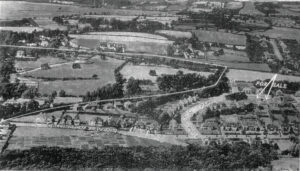
The following sales pitch appears underneath the photograph
“Frontages are available on Collington Rise at £7 0s. 0d. per foot. Minimum cost of house .is £1,000 0s. 0d.”
“Excellent 4 Bedroom house for sale at £1,700. Frontages in Collington Lane at £6 0s. 0d. per foot. Three Bedroom houses at -£1,350 with Garage. ”
“Beautiful row of Pine trees borders this part of the Estate, as soon as the existing road frontages are built on roads will be laid through the Estate opening u scone of the best building sites iii the South of England.”
1920 – Collington Manor Development Scheme
In 1920, a brochure on a proposed development scheme was published with sales particulars and a coloured map showing the layout proposed (first two images in gallery below).
Again, in 1927, a small part of the remaining estate was put up for sale by Private Treaty (last two images in gallery below)
Wrestwood Estate
Sir Edward Baldwin Malet, a Diplomat and Owner of Wrestwood Estate was born on 10th October 1837. He was a direct descendant of a close companion of William the Conqueror. It was therefore a noteworthy coincidence that he chose to domicile himself in Bexhill later in life. He married Lady Ermyntrude Sackville Russell, daughter of the 9th Duke of Bedford. Educated at Eton, he entered the diplomatic service and distinguished himself in four continents. His career culminated in the key post of British Ambassador in Germany. He was regularly summoned the Palace by Queen Victoria. Ill health forced Sir Edward to retire in 1895 and although he already had a residence near Monaco and a house in London, the couple chose Bexhill as their country retirement home.
The Malet’s mansion, Wrestwood, was created in 1896-97. The elegance of the interior was matched by the elaborately designed grounds. Sir Edward died on 29 June 1908. His widow erected the Malet Memorial Institute on the edge of Bexhill Down, latterly known as the Church of the Good Shepherd, Belle Hill, as a ‘place of recreation and religious instruction for the working men of the district….an alternative to the public houses‘. Lady Malet died in 1927 and Wrestwood became a girl’s boarding school in 1928. After the Second World War it was acquired by St Mary’s Wrestwood Educational Trust.
The house was built in 1897 by Sir Edward Malet the distinguished ambassador who held some of the most important diplomatic appointments in the Victorian Age. The architect was Mr E. H. Gray. The house had 46 rooms and a hot air heating system. It cost more than £8,000. Sir Edward died in June 1908.
In between the two world wars Wrestwood became the home of Lindores School. This school was originally founded at Linkwell, the old home of the Day family, in the High Street, Old Town. Lindores moved away from the town during the second world war and did not return.
St Mary’s School for Handicapped Children was founded in 1922 in Chislehurst. The School moved to Horam, Sussex and during the war was evacuated to Brecon, Wales. In 1946 it moved to Wrestwood and is, now, known as St Mary’s Wrestwood Educational Trust School.
In the gallery of images below, the first image shows the extent, in 1927, of the Wrest Wood Estate up for sale. the next image shows an advert for the sale or auction and the last is another brocure extract for a sale or auction in 1962.
The attempt to sell or develop the Wrestwood property, in 1927, resulted in its transformation in Lindores School. The second auction, in 1962, was for the southern part of the estate, the house and immediate grounds remaining part of St. Mary’s School, which was followed by the building of the “Glades”.
Click the images once for an enlarged view and then click the symbol top right to enlarge further. Close the images by clicking on the button at bottom right of the map.
In the following Gallery, the first image is a plan of the land around Wrestwood Road, the second is of Wrestwood Lodge and the third is of “The Glades”. Click on an image to see an enlarged image.
Broadoak
This was the residence of Henry Smith Lane upon his retirement from the Indian Civil Service. His son, Lieutenant-Colonel Henry Lane became known as the “father of local government” in Bexhill. In 1927, Broad Oak Manor was put on the market – the image on the right shows the front page of the sales brochure.
St. Mark’s Old Rectory & Glebe Land
St. Mark’s Church was built in 1842, largely of material from the No. 42 Martello Tower demolished at Bulverhythe, and which was brought by sea to the beach at the bottom of Cooden Sea Lane (now Road). From there it was transported by cart to the church site.
St. Mark’s was first served by curates of St. Peter’s, and the separate parish was not created until 1857 when it was described as “the district chapelry of St. Mark’s with a perpetual curator” – 10 years later the Ecclesiastical Commissioners ordered that the living should be a Rectory.
The original building of St. Mark’s church was enlarged in 1858 by the extension of the chancel, and in 1885 by that of a south aisle and an addition to the nave. In 1931 the Lady Chapel and a new vestry were added, a north aisle completed in 1963 and a new porch in 1970. The church institute was built in 1912.
Canon J. H. Simpson, who came as curate in 1852, resided at Signal House (later renamed Kewhurst House) which was one of the old telegraph stations of the coastguards and still retains the look-out tower. In 1879 he built the rectory which was bought by the Corporation in 1964 and demolished to provide part of a site for elderly people’s flatlets, a scheme that resulted in the opening of Alexander Court in 1970.
Projects That Did Not Materialise
The first attempt at planned expansion in Bexhill, which never materialised, was made by the Fielder family who owned the Pages estate from 1840. The scheme included roads named after the Habsburgs and a church for men of the Coast brigade. The Pages Home was demolished after the Second Word War and the estate developed with mainly bungalow residences.
A Hastings Syndicate, headed by George Veness and Joseph Brown, bought Cramps Farm near Holliers Hill in 1873 and laid out St John’s and St James’ roads which became the first roads to be adopted by the Bexhill Local Board.
Two attempts were made to cover the Barnhorn-Cooden are in building plots:
– 1912 – 147 plots on 120 acres of the Cooden Wood Estate
– 1923 – 835 acres of the Battle Abbey Estate covering three residential farms as well as marshlands
Only some of these plots were actually used for building.
Phantom Projects
The Cooden Wood Estate – 1912
On August 17th 1912, the Cooden Wood Estate was put up for Auction with particulars and plans for 147 housing plots but it did not sell.
Battle Abbey Estate – 1923
Barnhorn was bought by the abbey of Battle in Henry I’s reign. At the dissolution of the monasteries the property was given to Sir Anthony Browne, Master of the Horse to Henry VIII. It was sold to Sir Thomas Webster in 1719. By Indenture of Settlement dated 2nd May 1885 Sir Augustus Frederick Walpole Webster Bart. became tenant for life.
A Conveyance of Sale dated 29th April 1902 assured the property to Sir Webster. Failure of male issue occurred and the estate passed under his Will.
The Sackville Hotel
The following information is taken from “The Story of Bexhill” by L. J. Bartley.
The Sackville Hotel was originally a row of four dwellings, which were incorporated into the making of the Hotel. It was opened by Lord De La Warr in July 1890 at the start of the fashionable era of Bexhill-on-Sea, which would flourish up until the First World War when everything would change.
Viscount Cantelupe, the son of Lord De La Warr, stayed in the Sackville Hotel, with his family, moving to the Bexhill Manor House when restoration was completed, in 1892.
In 1897, the family sold the Sackville to the Frederick Hotels Ltd, which owned it for sixty years.
Between the wars, the Sackville declined, as did most of the old, grand establishments along the coast, mainly because peoples’ attitudes towards holidays changed, the maids looking after the children of wealthy families working abroad for the Empire was, also, declining and they no longer took the children on holiday to Bexhill.
WW2 changed the future of the Bexhill hotels even further – the schools, which had moved temporarily out of town into the safety away from the coast during the war, never came back and the need for hotel accommodation was no longer there.
In 1957, Frederick Hotels sold the Sackville and its contents by auction – in 1963 the building, itself, was sold and converted into flats.
It is from the auction, of 1963, that the two brochure pages and the map have been taken.
Highwoods Golf Course
On 17th June 1926, the auctioneers Messrs. Humbert and Flint and Messers Stevens and Sons, submitted for sale by auction about 30 acres of building land, adjoining the High-wood Golf Club, and having nearly 3,400 ft. of frontage to Ellerslie-lane, Turkey-road and Pear Tree-lane. The map shows these lots.
Stevens & Son, also, announced that they had been instructed to negotiate the sale of the remaining lots by private treaty at very nominal reserve price, which, they said, would present little difficulty in selling the land.
“Especially”, they said, “the plots in Pear Tree-lane, which must particularly appeal to anyone desirous of building in a neighbourhood possessing all the charm of rural surroundings, yet enjoying the amenities of an urban locality. Main drainage, gas, water and electric light are available. Pear Tree-lane being a public highway, there are no road charges, to be paid.”
Abbott & Abbott – Estate Agents
“The Homefinder” – 1948
The Bexhill Homefinder(the copy here is from June 1948) was first published on 4th August 1911 and this is how the “Bexhill Homefinder” introduced itself a few weeks before actual publication.
“A NEW BUSINESS PROPOSAL “THE BEXHILL HOMEFINDER”.”
“Many of our renders may have beard of “The Bexhill Homefinder, a paper which is now being compiled. and will shortly be published weekly in the interests of Estate and Property Owners, aa well as business men. In the usual way, the efforts of the local Press are mostly concerned in keeping the local circle well au fait with local events but the main object of the “Bexhill Homefinder” is to circulate all business information relating to the town so far as it relates to properties, houses, shops, golf, water, clubs and institutions at Bexhill, throughout the United Kingdom. “The Bexhill Homefinder” will put intending residents, property seekers and investors in touch with the very people sought for.”
“”The Homefinder” will be published simultaneously with many other local editions of Homefinder” and in the end 300 or more Homefinders will be published. The paper will contain just the local information that an attending resident would desire together with a list of properties that are available in the town and surrounding area. “The Homefinder” will give the prospective resident all the details that he requires about Bexhill rates, gas, electricity, churches, scholastic facilities, clubs, amusements, and so on to say nothing of the beautiful scenery and health-giving properties of the air, upon which a special notice will appear in “The Homefinder”.”
“”The Homefinder” will be of great importance to tradesmen in getting an early introduction to newcomers to Bexhill and the scheme is certain to be of great value to the town and to the residents. The publication is of a specialised character as every copy will go directly into the hands of those who are interested, and those likely to be interested, in properties or homes at Bexhill-on Sea”
Conclusion
This exhibition has given us the opportunity to display many of the museum’s maps and plans, some of which have not been seen by the public for many years.
Issues of wealth and class have divided Bexhill-on-Sea since it was laid out, the first dividing line being Sea Road which on the southern side of the railway line separated the ‘high class’ area of De La Warr Parade from the ‘trade’ area of John Webb’s Egerton Park estate. Today social divisions are less defined.
The nature of Bexhill-on-Sea has changed from a fashionable, high-class resort to a centre for independent schools and finally as a residential area with many nursing homes. Land development is still a very contentions issue and the debate continues.




